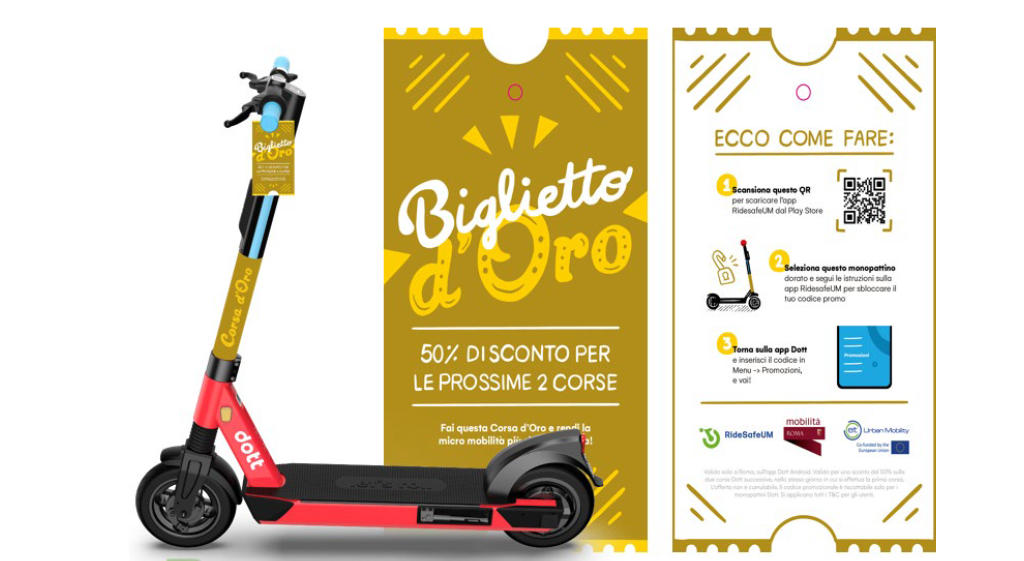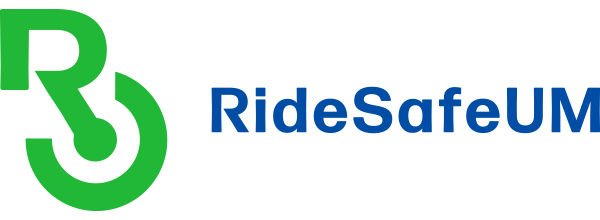The authorities in Rome are committed to promoting shared micromobility services as an efficient and environment-friendly means of transport. In the recent pilot led by CARNET, the shared micromobility operator Dott made e-scooters available for users to try out the RideSafeUM solution. The RideSafeUM module was not integrated into Dott’s app, so riders needed to use both Dott’s app and RideSafeUM’s app, which presented a challenge in terms of user experience.
According to the criteria set by Roma Mobilitá and Dott, the pilot area was built in the city centre, where Dott has the strongest presence and e-scooters are a very common mode of moving around. Roma Mobilitá supported the project by designing, evaluating, and reviewing results from the dashboard, as well as disseminating the efforts to engage with riders. In this case, the mobility regulations that are included in RideSafeUM are only applicable to e-scooters, as this is the vehicle type Rome was interested in managing under RideSafeUM.
To encourage participation in the pilot, voucher codes were created for the use of Dott’s vehicles. These codes were obtained after launching the RideSafeUM app and could be redeemed in Dott’s app for riding discounts. Additionally, distinctive stickers and advertising materials were added to the e-scooters so that they would stand out as potential users walked around Rome pilot areas. As with the other cities, there was a section of the RideSafeUM website dedicated to the Rome pilot test where the pilot was advertised, providing users with easy access to download both the RideSafeUM Rome and Dott’s apps, as well as comprehensive instructions and details on how to participate in the pilot test.

Ultimately, in order to evaluate the impact of the pilot we were able to obtain data from the developed dashboard, user surveys and finally, the direct feedback from the City Council. One of the main discovered challenges was related to battery consumption, as users reported a significant drop of battery while the app was in use. Considering this fact, the workplan for the second year of the project will include the optimisation of the computer vision algorithm since, from an application point of view, the computer vision module is the technology that has the greatest impact on battery consumption.
Following up on the computer vision feature, the designed algorithm was evidenced to be able to recognize lanes in real time through the phone or an external camera, allowing the app to match specific regulations for cycling or riding on each type of lane. In the initial phase of the pilot, tests were conducted to address concerns related to the video quality that could affect the reliability of the computer vision algorithm in detecting lane types. The issues were promptly identified and resolved, and the performance of the computer vision module was deemed to be excellent after testing.
The app’s ability to detect accidents is a significant feature. Although the pilot tests did not provide a representative sample for a full evaluation of this function, preliminary results indicate that it performs well, except in some very specific cases where a few false positives were detected. To ensure the viability of the commercial strategy, optimizing this “black box” function will be included in the 2023 work plan.
Although certain areas like the accident detection system and the overall battery consumption require improvement and further testing, this doesn’t imply that the RideSafeUM technology wasn’t successfully developed in 2022. It rather indicates the consortium’s commitment to enhancing the product’s competitiveness in the micromobility market.
In conclusion, the RideSafeUM pilot in Rome, which gathered a total of 62 unique users and 98 trips, has been successful in adapting to the city’s micromobility regulations and engaging users to utilize the app. It should be noted that the integration of the RideSafeUM module into Dott’s application was not possible, turning into a challenge when reaching out to potential users of the app. Consequently, the adoption rate is considered acceptable given the circumstances and its comparison with the Barcelona case. Despite the uncertainties surrounding the upcoming election and tender circumstances in 2023, Dott and Roma Mobilitá will focus on enhancing their user acquisition strategies to fully leverage the potential of the pilot during September and October of the following year, given Dott’s user base in the Italian capital. This will allow the consortium during 2023 to address challenges related to phone battery consumption and GDPR compliance, with additional information provided on GDPR coverage since the project’s inception. Moreover, optimization of the accident detection function is planned to ensure the commercial strategy’s viability.





